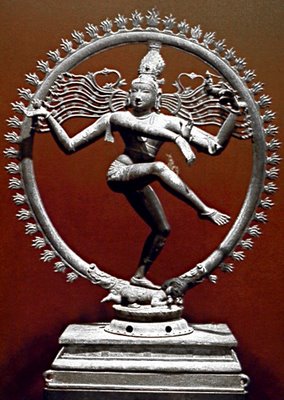Shiva Nataraja
 Chola dynasty, 12th century CE. Thanjavur, Tamil Nadu. Bronze.
Chola dynasty, 12th century CE. Thanjavur, Tamil Nadu. Bronze.This piece depicts the Indian Shiva Nataraja, god of destruction and of dance. Though this deity is known as a male, he is depicted in disguise as a woman. Shivas usually were depicted as having four arms, with hands gesturing to symbolize elements of the universe, such as creation, destruction, and protection. The rhythmic movement of the god's pose reflects complexity and balance, perhaps representing the delicate balance between the ongoing creation and death in the world. Yet, the facial expression is ultra-serene, utterly calm and dignified. The hair flows outward to form two wings, symbolizing once again the figure's deity, as legend states that the Shiva's power was in his uncut hair.
A series of bronzes from this period used this delicate form of the Shiva Nataraja as inspiration, and this tradition has carried into modern times - this piece most definitely became a complex and wonderful standard for Indian art.
Image:
Stokstad, Marilyn. "Art of India before 1200". Art History Interactive CD-ROM.
Source:
"Shiva as Nataraja - Dance and Destruction In Indian Art". Exotic India Art January 2001. Available online at
http://www.exoticindiaart.com/article/nataraja. Accessed 18 July 2006.
A series of bronzes from this period used this delicate form of the Shiva Nataraja as inspiration, and this tradition has carried into modern times - this piece most definitely became a complex and wonderful standard for Indian art.
Image:
Stokstad, Marilyn. "Art of India before 1200". Art History Interactive CD-ROM.
Source:
"Shiva as Nataraja - Dance and Destruction In Indian Art". Exotic India Art January 2001. Available online at
http://www.exoticindiaart.com/article/nataraja. Accessed 18 July 2006.

0 Comments:
Post a Comment
<< Home